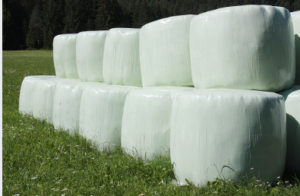Posted on March 30, 2023
The Importance of Silage Wrap
Silage wrap is an invaluable tool for farmers to protect their hay bales and reduce spoilage. Additionally, it helps keep your stock healthy and well-fed throughout the winter months.
Today, there is a wide selection of plastic film options for hay and silage wrapping. However, not all products are created equal; some offer stronger or weaker UV protection, tact (stickiness) or puncture resistance.
It Keeps Bales Fresh
Maintaining your bales’ freshness is critical to running a hay operation. Unprotected bales left outside without silage wrap are more susceptible to spoilage, ultimately costing you money in the long run.
Many farmers rely on silage wrap to keep their hay and other forages fresh. The wrap prevents microorganisms that spoil hay from taking hold.
The film can be constructed in five or more layers, depending on the product, and it typically features an oxygen barrier that prevents oxygen from entering the bale. It helps to reduce oxygen levels in forage, inhibiting bacterial growth and fungal or other diseases.
Silage wrap can expand and contract with temperature changes, making it more effective at preventing leaks and shielding the bale from weather elements. It makes it ideal for farmers living in climates where rain or snow is likely to occur frequently; this helps preserve hay for more extended periods.
 Another advantage of silage wrap is that it makes the hay more digestible for your livestock. However, according to Dennis Buckmaster, an agricultural engineer at Purdue University, unwrapped hay can lose up to 25% of its dry matter during storage – meaning your stock won’t receive as much nutritional benefit.
Another advantage of silage wrap is that it makes the hay more digestible for your livestock. However, according to Dennis Buckmaster, an agricultural engineer at Purdue University, unwrapped hay can lose up to 25% of its dry matter during storage – meaning your stock won’t receive as much nutritional benefit.
Cattle and horses may face nutritional deficiencies if their food supplies don’t contain enough essential vitamins and minerals. Silage, however, provides more essential vitamins and minerals than hay which may be difficult to digest for animals.
Silage preserves essential nutrients and is a more cost-effective option than hay due to its lower water content. Furthermore, silage is more environmentally friendly since it can be stored for an extended period and recycled once used.
Some people choose to enwrap their hay in different colours for special occasions or to raise awareness for a cause. For instance, you could enwrap your cotton bales purple during Breast Cancer Awareness Month or yellow to support the Children’s Medical & Research Foundation.
It Keeps Pests Out
Pests and other rodents can damage bales significantly, but silage wrap is an effective solution that keeps these animals out while saving you money. Furthermore, it helps your crops grow better by providing a protective barrier.
Regarding crop wraps, various factors determine how effective it needs to be. For example, the type of crop, the climate where storage takes place, and moisture content all play a role in determining how effective the wrap needs to be.
Typically, grass and straw silage must be wrapped in 2.5 to 4 layers of netting and film, depending on the plant being harvested. Coarse-stemmed material like maise requires at least 4 or 5 net and film protection layers.
Plants exert considerable strain on both nets and films, thus necessitating more layers to be applied.
Start with a few layers of plastic wrap and gradually increase the number as needed for your farm. That way, you can assess how much protection is provided and whether the extra expense is justified.
Silage wrap not only protects your crop but also helps reduce landfill waste. It is because it’s recyclable, making it an environmentally responsible choice for farmers and consumers.
It’s Recyclable
Farmers increasingly realise they can recycle their used bale wrap instead of throwing it away. Not only does this save them money, but it is also better for the environment.
Cleanfarms in Bruce County, Ontario, is conducting pilot projects to collect and recycle twine and bale wrap. They aim to expand their reach and eventually provide this service nationwide.
The company believes this is an essential step towards reducing landfill waste. They are collaborating with local dairy farmers and agribusinesses to offer this service.
They take pride in promoting their farming community’s ‘clean, green’ image by advocating sustainable practices and helping other farmers avoid using traditional black or coloured plastic bale wrap.
Farming offers many benefits to farmers, but they still face challenges when disposing of waste. Landfilling is the most common disposal option, and it can be expensive. Burning is another standard option, but it may release hazardous chemicals into the air.
